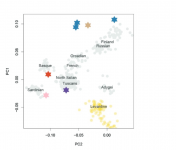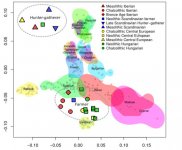Sorry, just saw this post:
Alan;467048]Dodecad K10a the first and most used source for Red Sea percentages as far as I know.
Ah, now I see the source of my confusion. I'm familiar with the Dodecad 10a percentages for "Red Sea", and your numbers seemed way off.
Alan:Taking into account the Bronze and early Iron Age Armenian samples and how they almost lacked or had noise percentage of any Red Sea component, this is clearly an evidence that all modern Northern Middle Eastern population as well many South European (no matter they like it or not) have some Afro-Asiatic admixture. In the Northern Middle East among non Semites it is around ~10-15%. Among Semites such as Assyrians it is ~25% and modern Levantines such as Lebanese ~40%! The rest of their aDNA is probably pre Afro_Asiatic Levantine.
I didn't read it carefully enough. So, now that I'm clear that the numbers refer to "Afro-Asiatic", my question becomes where do you get your figures for "Afro-Asiatic"? I'm aware of the existence of "Afro-Asiatic" languages, but not of an "Afro-Asiatic" component.
I did assume that some very noisy percentage of it was always part of it at least among some EEF farmers. It is possible that some Red Sea was already present among the earliest farmers but Red Sea is not automatically Red Sea most of the Red Sea showing up in EEF is actually the EEF portion of Red Sea itself.
Actually there's quite a bit of Red Sea in the early farmers of Europe:
Stuttgart: 4.45
Hungarian Early Neolithic: 5.49
Even in Copper Age Hungary it was still at 4.59.
Unfortunately, I can't find a 10A run on Otzi or Remedello. (If someone has a link that would be great.) It would be particularly interesting to compare them to the "Red Sea" level for North Italians (.8), Tuscans (2.3), Sicilians (5.6).
“I remember K10a Red Sea description as a even mix of Southwest Asian and East African. And according to a comment of Dienekes East African is like even mix of SSA and Caucasian(most likely EEF). So Red Sea 3/4 EEF 1/4 SSA fits.”
I don’t doubt that there might be some SSA in “Red Sea”; however, I’m not sure that ¼ is the right proportion.
Let’s look at it this way. These are the proportions of Red Sea in some northeast European and East European populations:
Finns 2.0
Lithuanians 1.9
Russians 1.6
Poles 1.2
I don’t recall ever seeing that Finns are .5 SSA. Their only extra-West Eurasian ancestry is Siberian, so far as I know.
“The Southwest Asian component itself contains like ~50% Red Sea if you compare K10a to World9 calculator this get's obvious.”
To be precise, it depends on the population. Southwest Asian in Tuscans on K12b is 7.3. Red Sea is 2.3. That’s much less than 50%. In other groups like the Finns, it’s a lot more than 50%. Southwest Asian in them is 2.2, and Red Sea is 2.0.
“According to that they have 6.1% Red Sea. And I honestly doubt that all of it in South Europe is Neolithic European but majority of it probably Semite. That also makes historically sense. If we expect that max 2% of it is EEF Neolithic. Than 4% is Afro_Asiatic related, that makes a total of 12% (Semite) influx into Sicily for example. Thats significantly less than Lebanon with 40% but it's there.”
I don’t see how you can be so secure in your conclusions based on the evidence in our possession. We know that a Copper Age Hungarian had 4.59 “Red Sea”. I wish I had a figure for Remedello, but I don’t think it would be far off to assume that they had about the same amount given all the analyses we’ve seen. Now, we don’t have any samples from further south in Italy for either the Copper Age or the Bronze Age. So, we don’t know if that approximately 4.6 “Red Sea” was cut by the Yamnaya invasions, and the later Celtic ones. That might be a permissible conclusion given the 2.3 number for Toscana, and the .8 for northern Italians. Now, turning to the southern Italians/Sicilians, we don’t know, as I said, what “Red Sea” number they had before the Yamnaya invasions. What we do know is that they weren’t as affected by the Yamnaya invasions, and the Yamnaya invasions which did affect them might have been rather different than the ones that impacted central and Northern Europe.
So, absent some ancient dna how could we possible know that “the majority of it is probably Semite”? What if 3% or 4% was there since the Neolithic ? Then, I don’t know what “Semite” means in this context. Again, that’s a linguistic term. If by that you mean 12% of the ancestry of southern Italians/Sicilians comes from a few Phoenician emporia I think that’s highly unlikely. If we’ve learned anything, it should be that significant changes in the genome come from significant migrations.
If, on the other hand, you’re saying there was some impact from Red Sea heavy populations during the Muslim occupation of Sicily and briefly of mainland southern Italy, that is much more likely. That would have come from a heavily Berber group. Berbers have nothing to do with Semites other than a shift In most cases to a Semitic language (Arabic). (Berbers, from what I can make out, are predominantly EEF people with perhaps some archaic North African forager and a big chunk of mostly recent SSA, i.e. post Arabic slave trade.) Obviously, some Levant derived people might have formed part of the invading forces.
If we’re going to speculate about the impact of
this invasion and occupation (not a
Semite percentage), I think ydna studies are a pretty good guide. Numerous scholars have attributed about 6% of the yDna of Sicily, in particular, to those invasions. Very little mtDna can be attributed specifically to them. So, if I were going to speculate, I’d say the autosomal impact might be around that or a little less.
The only other possibility would be some input from slavery in the Roman era. Again, as I've said before, I don' know why any slaves from the Levant would have such a disproportionate effect compared to slaves from northern and western and eastern Europe.
Bottom line, I'm no longer doing all that much speculating. That was much more fun when it seemed we’d never get ancient dna and we couldn’t be proven wrong.

Seriously, I’ll wait for samples from these periods to see what changes different migrations brought.
“The oldest Bronze Age Armenian samples have 0-2% Red Sea this rises with every century the samples get younger, by few percentage ending by modern Populations with 5%(non Semite NWA) -17%(Semite Levantines) Red Sea”."
I have the same skepticism about these conclusions. We don’t have any Neolithic samples from this area. What if it was at 4-5% levels as it was in Neolithic Europe. Then, these low levels of “Red Sea” might just be the result of admixture from the steppe. After all, these kinds of burials are those of the new “elite”. What was the “Red Sea” level in those who survived? Perhaps, after some good amount of time, there was a resurgence, as there was in Europe, through some admixture.
I’m not saying it all didn’t happen in the way that you’re speculating. I’m just saying there are alternate possibilities, and we won’t know until we have the relevant ancient dna.



